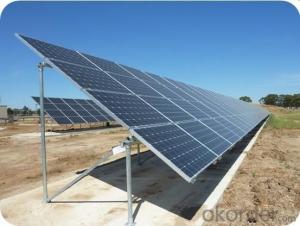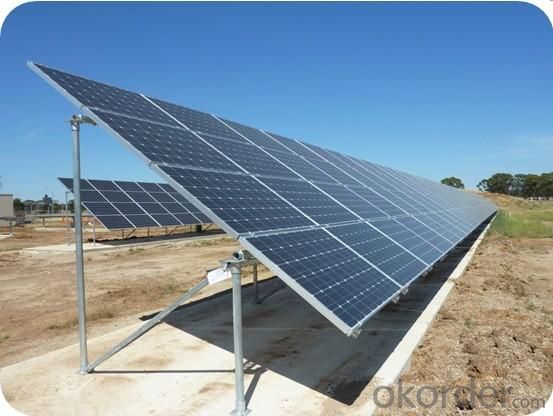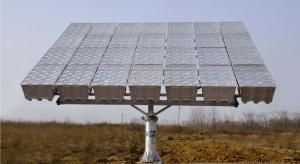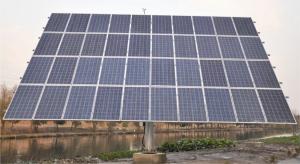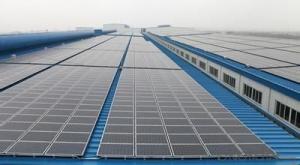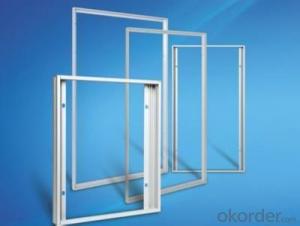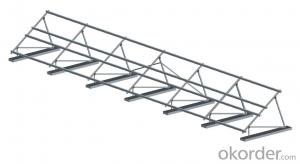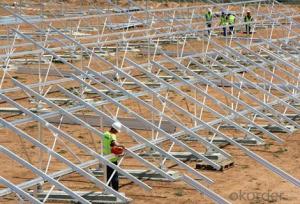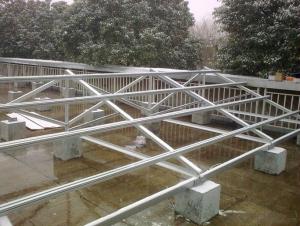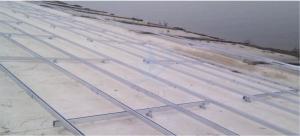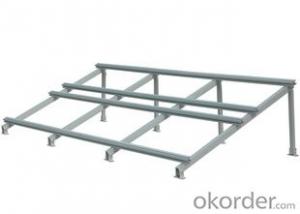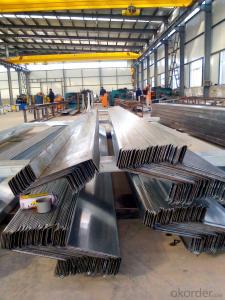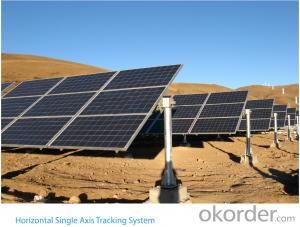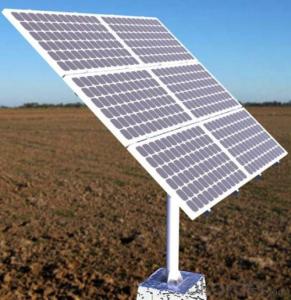Solar Mounting System for Solar Panel Mounting Brackets
- Loading Port:
- China Main Port
- Payment Terms:
- TT OR LC
- Min Order Qty:
- -
- Supply Capability:
- -
OKorder Service Pledge
Quality Product, Order Online Tracking, Timely Delivery
OKorder Financial Service
Credit Rating, Credit Services, Credit Purchasing
You Might Also Like
Product Description
Solar Panel Mounting Bracket
1, mainly used in large-scale photovoltaic power station project, the ground used to support the photovoltaic panels components.
2, product main frame profile is made of Q235B steel plate a cold bending forming, economic, durable, easy to install.
3, surface using hot-dip zinc treatment, durable resistance to corrosion.
4, our products have been in China, gansu, shanxi, shandong, sichuan and other large power station project put into use, obtained the customer consistent high praise.
| Model Number | HL-PS-001 |
| Application | Commercial |
| Installation Site | Open Area |
| Material | Steel |
| Standard | GB,AISI,ASTM,BS,DIN,JIS |
| Installation Angle | According to customer's request |
| Installation Height | According to customer's request |
| Wind Load | 90m/s |
| Snow Load | 1.8KN/m² |
| Solar Panel Size | Any |
| Warranty | 10 years |
| Service life | 25 years |
| Packaging Detail | Standard Export Carton, Plywood Pallet and Case. |
| Delivery Detail | 1-2 weeks according to the order quantity |
Our Services
1. Can provide the customer reference samples
2. Support customized to meet the need of customers design and processing.
3. Provide after-sales construction guidance.
- Q: Can a solar mounting system be used in areas with solar incentives for warehouses?
- Yes, a solar mounting system can be used in areas with solar incentives for warehouses. In fact, it is highly recommended to utilize solar mounting systems in such areas as they provide a secure and efficient way to install solar panels on warehouse roofs or open spaces. These systems not only maximize the solar energy generation potential but also help warehouses take advantage of the available solar incentives and reduce their energy costs.
- Q: Can a solar mounting system be installed on a rooftop with a wood shingle roof?
- Yes, a solar mounting system can be installed on a rooftop with a wood shingle roof. However, it is important to ensure that the installation is done properly, taking into consideration the weight and structural integrity of the roof. Consulting with a professional installer is recommended to ensure a safe and secure installation.
- Q: Specification for installation of fire pipe support
- The size and type of the bracket should be based on the actual situation to determine the stent hole should be used to open the hole drilling, is strictly prohibited to use electricity, gas welding openings.
- Q: Are there any specific requirements for streetlight or outdoor lighting design when using a solar mounting system?
- Yes, there are certain requirements for streetlight or outdoor lighting design when using a solar mounting system. The design should consider the specific location and orientation of the solar panels to ensure maximum exposure to sunlight. Additionally, the lighting fixtures should be compatible with the solar system, providing efficient and reliable performance. A proper assessment of the local climate, shading, and energy needs is also crucial for an effective streetlight or outdoor lighting design with a solar mounting system.
- Q: Are there different types of solar mounting systems?
- Yes, there are different types of solar mounting systems. Some common types include roof-mounted, ground-mounted, and pole-mounted systems. Each type has its own advantages and considerations, depending on factors such as available space, orientation, and local regulations.
- Q: Are there any specific requirements for installing a solar mounting system in a desert?
- Yes, there are specific requirements for installing a solar mounting system in a desert. Some of the key considerations include the need for a sturdy and durable mounting structure to withstand high winds and sandstorms, proper grounding to prevent electrical hazards, protection against intense sunlight and temperature fluctuations, and the use of materials and coatings that can withstand the harsh desert environment. Additionally, the system should be designed to minimize dust accumulation on the solar panels, as dust can significantly reduce their efficiency.
- Q: Are there any specific requirements for installing a solar mounting system on a rooftop with rooftop HVAC ducts?
- Yes, there are specific requirements for installing a solar mounting system on a rooftop with rooftop HVAC ducts. It is important to consider the location and layout of the HVAC ducts to ensure that they do not obstruct the installation of the solar panels. Proper spacing and clearance must be maintained to allow for proper airflow and functionality of the HVAC system. Additionally, the mounting system needs to be designed and installed in a way that does not compromise the integrity of the rooftop or the HVAC ducts. Consulting with a professional solar installer is recommended to ensure compliance with all requirements and to optimize the system's performance.
- Q: What is the expected maintenance schedule for a solar mounting system?
- The expected maintenance schedule for a solar mounting system may vary depending on factors such as the type of system, location, and environmental conditions. However, in general, solar mounting systems typically require minimal maintenance. Routine inspections to ensure the integrity of the system, such as checking for loose or damaged components, may be recommended annually or biannually. Additionally, regular cleaning of the solar panels to remove dirt, debris, and any potential shading obstructions is advisable to optimize performance. Overall, a well-designed and properly installed solar mounting system should have a relatively low maintenance requirement.
- Q: How does a solar mounting system affect the roof's heat transfer?
- A solar mounting system can affect the roof's heat transfer by creating a gap between the solar panels and the roof surface. This gap allows for better airflow, reducing the amount of heat that is transferred from the roof to the interior of the building. As a result, the roof stays cooler, which can help in reducing energy consumption for cooling purposes.
- Q: Can a solar mounting system be installed on a private residence or home?
- Yes, a solar mounting system can be installed on a private residence or home. The mounting system allows for the installation of solar panels on the roof or ground of a private residence, enabling the generation of renewable energy for personal use.
Send your message to us
Solar Mounting System for Solar Panel Mounting Brackets
- Loading Port:
- China Main Port
- Payment Terms:
- TT OR LC
- Min Order Qty:
- -
- Supply Capability:
- -
OKorder Service Pledge
Quality Product, Order Online Tracking, Timely Delivery
OKorder Financial Service
Credit Rating, Credit Services, Credit Purchasing
Similar products
Hot products
Hot Searches
Related keywords
